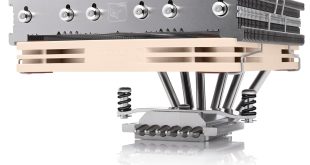Today we are using a Core i5 655K processor which is clocked at 3.2ghz and is a dual core design with Hyperthreading support. We are using the Freezer 11 LP against the Thermaltake Slim X3 low Profile cooler and a reference Intel solution.
Processor: Intel 655K Core i5 CPU (review)
Chassis: Lian Li PC-Q11 Mini ITX (review)
Thermal Paste: Noctua NT H1
Power Supply: Corsair AX850 (review)
Memory: 8GB of Hyper X DDR31600mhz by Kingston (review)
Graphics: Sapphire HD5670 Ultimate Edition (single / Crossfire reviews)
Hard Drives: 2.5 inch 200GB and 320GB Fuji
Motherboard: Zotac H55 Mini ITX Wifi
Room ambient temperatures were kept at a steady 25c via air conditioning in our test labs. Idle readings are measured after 30 minutes of testing in the desktop after a fresh boot. We achieved our load results by looping Cinebench R11.5 with Furmark for 20 minutes then taking the highest result throughout this time period.
The Arctic Cooling Freezer 11 LP manages to outperform the Thermaltake Slim X3 by 2c at reference speeds, and 7c against the reference Intel cooler.
While we wouldn’t recommend people run overclocked systems in a small ITX case such as this we decided to crank the CPU speeds to around 3.6ghz without increasing core voltage.
Processor temperatures only rose by 4c under load which is a strong result. Air ambient temperatures increased by a single degree when under load also. It would be possible to raise the overclock higher, but we see no need for a media center system like this – we are already sitting at a solid level of performance with very impressive temperatures.
Return to ambient (idle) is a feature we have recently added to our reviews … we measure the time it takes for a solution to return to idle temperatures, immediately after full load. The faster the time, the better the cooler – for example a Noctua NH D14 cooler will return an Intel processor to idle temperatures much faster than a reference cooler. This is a good indication of how quickly a heatsink can dissipate heat.
14 seconds is a good result for a low profile cooler such as the Freezer 11 LP.
Recently we have changed our method of measuring noise levels. Ambient noise in the room is kept as low as possible. We measure from a distance of around 1 meter from the chassis and 4 foot from the ground to mirror a real world situation.
The room rates as 20-21dBa – the air conditioning unit in the far corner of the room causes this.
KitGuru noise guide
10dBA – Normal Breathing/Rustling Leaves
20-25dBA – Whisper
30dBA – High Quality Computer fan
40dBA – A Bubbling Brook, or a Refridgerator
50dBA – Normal Conversation
60dBA – Laughter
70dBA – Vacuum Cleaner or Hairdryer
80dBA – City Traffic or a Garbage Disposal
90dBA – Motorcycle or Lawnmower
100dBA – MP3 player at maximum output
110dBA – Orchestra
120dBA – Front row rock concert/Jet Engine
130dBA – Threshold of Pain
140dBA – Military Jet takeoff/Gunshot (close range)
160dBA – Instant Perforation of eardrum
The cooler is generally quiet, maxing out at 32.7 dBa under full, extended load. The case also helps deliver a reasonable level of sound isolation from internal components.
 KitGuru KitGuru.net – Tech News | Hardware News | Hardware Reviews | IOS | Mobile | Gaming | Graphics Cards
KitGuru KitGuru.net – Tech News | Hardware News | Hardware Reviews | IOS | Mobile | Gaming | Graphics Cards






